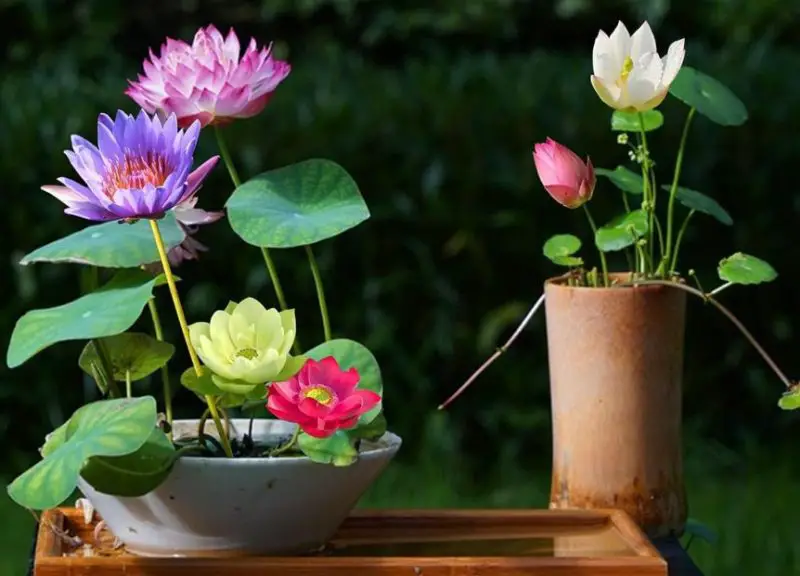Growing lotus flowers from seeds is one of the most rewarding gardening experiences you can enjoy. These ancient and symbolic blooms are not only visually stunning, but they also carry a serene beauty that transforms any pond or water feature. Understanding how to grow lotus flowers from seeds for full blooms ensures that your efforts result in vibrant, long-lasting flowers.
For many gardeners, the idea of growing lotus from seed seems daunting. However, with the right knowledge and preparation, even beginners can successfully grow these aquatic treasures. Learning how to grow lotus flowers from seeds for full blooms starts with knowing their unique growth cycle and what conditions they require to thrive.
This guide will walk you through the entire process, from selecting healthy seeds to watching your lotus bloom in full glory. By the end, you’ll have the confidence and practical skills to grow lotus flowers from seeds and enjoy their lush blooms year after year.
Understanding the Lotus Plant

Botanical Background and Symbolism
The lotus plant belongs to the Nelumbonaceae family and has been revered in cultures across Asia and Egypt for thousands of years. Often confused with water lilies, lotus flowers are distinct in their ability to rise above the water, creating a bold, dramatic presence. The most common species cultivated are Nelumbo nucifera (sacred lotus) and Nelumbo lutea (American yellow lotus), both producing wide, cup-shaped blooms in shades of pink, white, and yellow.
Beyond their beauty, lotus flowers hold deep spiritual and cultural significance. In many Eastern traditions, they symbolize purity, rebirth, and enlightenment due to their ability to thrive in muddy water and emerge clean. Growing these iconic flowers from seeds allows you to experience their transformation firsthand and adds a touch of timeless elegance to your garden.
Growth Habits and Life Cycle
The life cycle of a lotus begins with dormancy during the colder months. Once temperatures rise, they begin to sprout vigorously. Lotus plants produce long, flexible stems, rounded leaves that can either float or rise above the surface, and impressive blooms that open in the morning and close at night. Depending on the climate, blooming can start in late spring and continue through summer into early fall.
Understanding this cycle is essential when learning how to grow lotus flowers from seeds for full blooms. Each stage requires specific care, from proper seed preparation to planting at the right time and ensuring adequate sunlight and water temperatures. With attention to these needs, you can encourage strong plants and beautiful, frequent blooms.
Preparing Lotus Seeds for Germination
Choosing Quality Lotus Seeds
To begin your lotus-growing journey, you need viable, high-quality seeds. Lotus seeds are typically dark brown or black, hard-shelled, and oval in shape. You can purchase seeds from reputable garden centers or online sellers. Ensure that the seeds are mature and not cracked or moldy, as damaged seeds often fail to germinate.
One way to test seed viability is by placing them in warm water. Viable seeds will usually sink within 24 hours, while those that float are likely empty or nonviable. Discard floating seeds and move forward with the ones that sink to the bottom of the container.
Scarifying the Seed Coat
The hard outer shell of lotus seeds makes them resistant to water penetration, which can delay or prevent germination. Scarifying the seed coat helps to overcome this by allowing moisture to reach the inner seed. To do this, gently file or sand one end of the seed using a metal file or sandpaper until the pale, inner layer is just visible. Be careful not to damage the seed core, as this can ruin its viability.
Once scarified, place the seed in a clear container of warm water. Keep the container in a sunny spot, changing the water daily to prevent bacterial growth. Within a few days, you should notice the seed swelling, and a green sprout may begin to emerge from the opening.
Monitoring Early Growth
After a few days to a week, sprouted lotus seeds will produce a curled stem with small, floating leaves. Continue to monitor water temperature and cleanliness. Optimal water temperature for germination is between 75°F and 85°F (24°C to 29°C). Keeping the seeds in a warm, bright location will encourage stronger and quicker growth.
Once the seedlings have developed a few leaves and the root system is visible, they are ready to be transplanted into soil. At this point, you can begin the next phase of learning how to grow lotus flowers from seeds for full blooms: planting the seedlings in containers or ponds.
Planting Lotus Seedlings in Soil
Choosing the Right Planting Container
Lotus plants can grow in ponds, water gardens, or large containers. If you’re planting in a pot, choose one that is wide and shallow with no drainage holes. A diameter of 12 to 24 inches and a depth of at least 6 to 8 inches works well for young lotus plants. If you plan to transfer them to an outdoor pond later, starting them in containers gives you better control over early growth conditions.
The container should be heavy enough to stay submerged and stable once filled with soil and water. Avoid using plastic buckets with handles or holes, as they can float or tip easily. Clay or ceramic pots work best for long-term growth.
Soil Selection and Preparation
Lotus flowers grow best in heavy, loamy soil. Avoid using potting mix or sandy soil, as they can float or cloud the water. A mixture of garden topsoil and a small amount of clay is ideal. Fill the container with about 4 to 6 inches of this soil mixture, and gently press it down to remove air pockets.
Create a shallow hole in the center of the soil and place the seedling carefully into the hole. Cover the roots with soil, but leave the sprout and leaves exposed above the surface. Press gently to secure the seedling in place.
Adding Water and Establishing Growth
Once the seedling is planted, slowly add warm, dechlorinated water to the container until the water covers the soil by about 2 to 4 inches. Be careful not to disturb the soil or the young plant. Place the container in a sunny spot where it receives at least 6 hours of direct sunlight per day.
As the plant grows, it will produce more leaves and longer stems that float or stand above the water. When the leaves begin to rise significantly, you can gradually increase the water level. This simulates the natural environment and encourages strong root development and vertical growth.
Caring for Young Lotus Plants
Managing Sunlight and Temperature
Lotus plants thrive in full sun. Make sure your plants receive a minimum of 6 to 8 hours of direct sunlight daily. If you’re growing them indoors or in a greenhouse, placing them near a south-facing window or under grow lights can help meet their light requirements.
Water temperature also plays a crucial role in their development. Keep the water warm, ideally between 75°F and 85°F. If you’re growing lotus outdoors in cooler climates, wait until after the last frost to move them outside. Cold water can stunt growth or kill young plants.
Fertilizing for Vigorous Growth
Once your lotus has established several leaves and appears to be growing steadily, you can begin fertilizing. Use a slow-release aquatic fertilizer formulated for flowering water plants. Start with a light application to avoid burning the plant, and increase gradually as the plant matures.
Fertilizing encourages robust root systems and frequent blooming, which is essential for those learning how to grow lotus flowers from seeds for full blooms. Be mindful not to overfeed, as this can lead to excessive leaf growth at the expense of flowers.
Pruning and Maintenance
Remove any yellowing or damaged leaves regularly to maintain plant health and prevent disease. This also directs the plant’s energy toward new growth and blooming. Clean the water occasionally and remove debris, algae, or insects that may gather on the surface.
Keep an eye on the plant’s overall appearance. If growth slows or the leaves start to curl, reassess the sunlight, temperature, or nutrient levels. Prompt adjustments help the plant recover quickly and stay on track toward blooming.
Encouraging Full Blooms
Understanding Bloom Cycles
Lotus flowers typically begin blooming in late spring or early summer, depending on your climate. Once the plant has produced a full canopy of leaves, it will start pushing up flower buds. These blooms last about 3 to 5 days, opening in the morning and closing at night.
For consistent blooming, the plant must receive steady sunlight, warm temperatures, and proper nutrition. Regularly removing spent flowers and pruning helps redirect the plant’s energy to developing new buds.
Environmental Factors That Affect Blooming
Several environmental factors can influence the success of blooming. Lotus flowers are sensitive to shade, sudden drops in temperature, and low nutrient availability. Even brief exposure to cold weather can delay or prevent blooming for the season.
Water clarity and depth also matter. Murky or stagnant water can hinder photosynthesis and attract pests. Keeping the growing environment clean, warm, and well-lit creates the best chance for vibrant, long-lasting blooms.
Bloom Duration and Flower Care
When your lotus flowers begin to bloom, enjoy their delicate beauty while they last. Each flower may last only a few days, but healthy plants will continue producing new blooms throughout the summer. Removing fading blooms helps promote the next cycle of flower production.
To preserve the beauty of individual blooms, avoid splashing or moving the plant unnecessarily during flowering. You can even collect spent flowers to dry and use for decoration, as they retain their shape and fragrance well.
Overwintering and Long-Term Lotus Care
Preparing for Dormancy
As temperatures drop in the fall, lotus plants begin to enter dormancy. Leaves yellow and die back, and the plant stops blooming. This is a natural part of the growth cycle and signals that it’s time to prepare the plant for winter.
Stop fertilizing and allow the leaves to wither naturally. Trim dead leaves close to the base, but avoid cutting the rhizomes or roots. Reduce water levels slightly if the plant is in a container, but never let the soil dry out completely.
Indoor Storage for Cold Climates
In colder regions, you may need to bring container-grown lotus indoors to protect them from freezing. Store the pot in a cool, dark place like a basement or garage, where temperatures stay above freezing but below 50°F (10°C). Cover the soil with a bit of damp newspaper or cloth to retain moisture.
Check periodically to ensure the soil remains slightly damp. In early spring, you can bring the plant back to a warm, sunny location and resume watering to encourage new growth.
Restarting the Bloom Cycle
When spring returns, gradually reintroduce the plant to sunlight and warm water. As temperatures rise and days grow longer, new leaves will emerge. Resume fertilizing once several leaves appear, and adjust the water level accordingly.
Over time, your lotus will grow stronger and bloom more consistently. Following these steps each season ensures your lotus plants stay healthy and continue to reward you with stunning flowers.
Common Problems and How to Solve Them
Yellowing Leaves or Stunted Growth
Yellow leaves are often a sign of low nutrients or poor water quality. Make sure the plant is receiving enough light, and consider adding a mild dose of aquatic fertilizer. Regular water changes can help keep the growing environment clean.
If growth is stunted, check the temperature. Cold water or air can delay development, especially in early stages. Move the plant to a sunnier or warmer location if needed.
Lack of Blooms
If your lotus is growing well but not blooming, it may be due to insufficient sunlight, over-fertilization, or overcrowding in the pot. Ensure at least 6 hours of full sun, reduce excess leaves, and give the plant space to spread its rhizomes.
Sometimes, it may simply take more time. Young lotus plants often bloom more reliably in their second growing season once their root system has fully matured.
Pests and Disease
Lotus plants are relatively pest-resistant but can occasionally attract aphids, caterpillars, or fungal infections. Spray with water or use organic insecticidal soap for minor infestations. Keep the area around the plant clean and remove decaying debris regularly to prevent disease.
FAQ About How to Grow Lotus Flowers from Seeds
How long does it take to grow lotus flowers from seeds?
When learning how to grow lotus flowers from seeds, you can expect germination to occur within 3 to 7 days after scarification. However, it typically takes 2 to 3 months for the plant to mature enough to produce its first blooms. Full flowering may take longer, especially for young or newly started plants.
What is the best time to plant lotus seeds?
The best time to grow lotus flowers from seeds is in late spring or early summer, when temperatures consistently stay above 75°F (24°C). Warm temperatures and long daylight hours are essential for strong growth and full blooms.
Do lotus flowers bloom in the first year from seed?
If conditions are ideal, lotus flowers can bloom in their first year. However, many gardeners notice that full blooming often occurs in the second year as the plant becomes more established. With proper care, including sunlight, fertilization, and warm water, blooming in the first year is possible.
Can I grow lotus flowers from seeds in a container?
Yes, one of the most practical methods for how to grow lotus flowers from seeds is to use wide, shallow containers. Containers allow you to control the growing environment, making it easier to maintain water temperature, sunlight, and fertilization.
Do I need to fertilize lotus seedlings?
You should not fertilize lotus seedlings until they develop several leaves and a strong root system. For those learning how to grow lotus flowers from seeds for full blooms, introducing fertilizer too early can harm young plants. Wait at least 4 to 6 weeks after germination to apply a low dose of aquatic fertilizer.
How much sunlight do lotus flowers need to bloom?
Lotus flowers need at least 6 to 8 hours of direct sunlight each day to produce full blooms. If you’re growing lotus from seeds, be sure to place your container or pond in a bright, sunny location. Lack of sunlight is a common reason for poor or delayed blooming.
Can I grow lotus flowers indoors?
While it is possible to grow lotus indoors, it’s more challenging due to limited sunlight and space. If you attempt this method, provide a south-facing window or use grow lights. Understanding how to grow lotus flowers from seeds indoors requires extra attention to warmth, lighting, and humidity.
Why aren’t my lotus flowers blooming?
If your lotus is not blooming, check the amount of sunlight, ensure the plant is not overcrowded, and make sure you are not over-fertilizing. Common mistakes when figuring out how to grow lotus flowers from seeds for full blooms include insufficient light, cool temperatures, and poor water quality.
How deep should water be when growing lotus from seeds?
In the early stages, water should be just a few inches above the soil to help young plants establish themselves. As the plant matures, you can increase the water depth to 12 to 18 inches. Adjusting water depth gradually is key to success when learning how to grow lotus flowers from seeds.
Conclusion
Learning how to grow lotus flowers from seeds for full blooms is a journey filled with beauty, patience, and reward. From the moment you scarify a seed to the day the first flower opens, every step teaches you more about this ancient and elegant plant.
By understanding each stage of the growth process and providing the right care, you can cultivate thriving lotus plants that bloom year after year. Whether you grow them in a small container or a full pond, lotus flowers bring a sense of peace, elegance, and natural wonder to any space.






